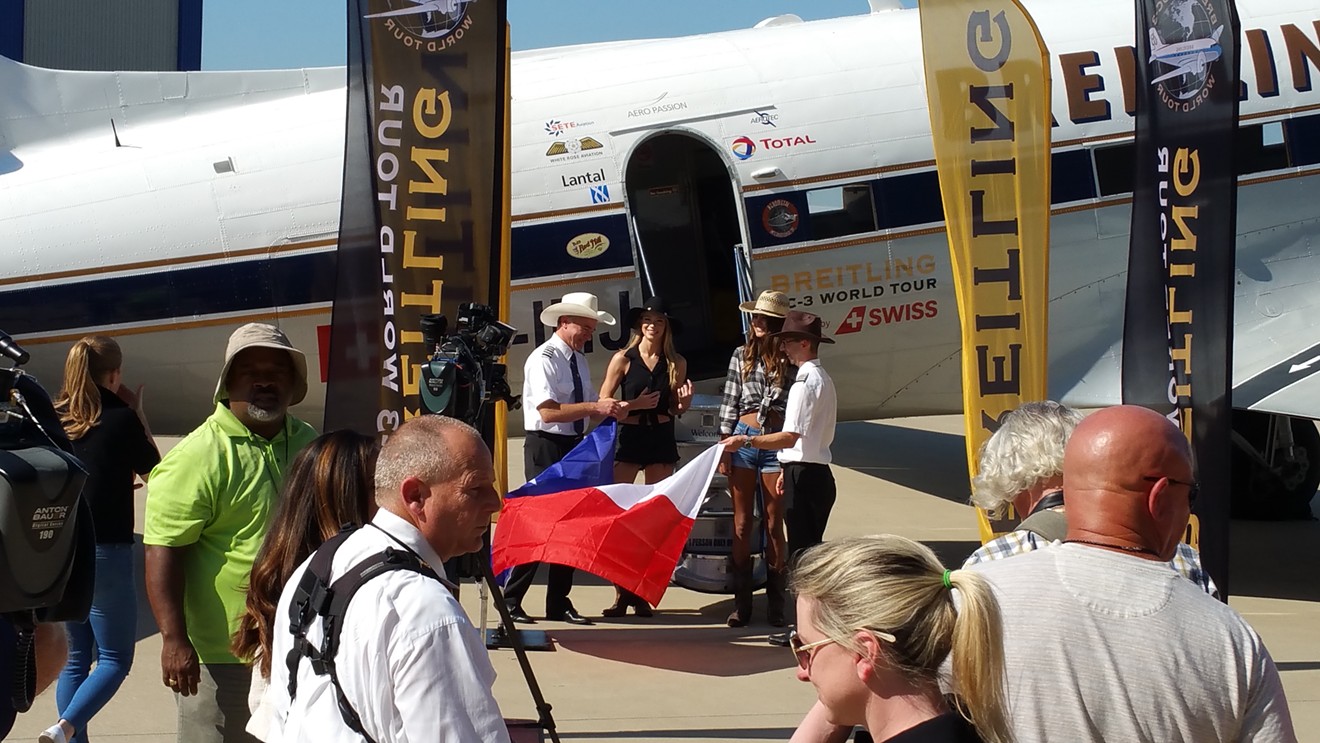You know you’re witnessing a particular kind of aviation history when the models show up. A pair of them in jean shorts and cowboy hats stalked the flight line at Addison Airport, hired to be eye candy for the photographers chronicling the North Texas visit of a vintage DC-3 airplane.
Few airplanes deserve to be called historically significant. The DC-3 earns it several times over. It had the range and durability to be the first cost-effective airliner, serve in World War II (including serving as a paratroop transport during D-Day) and become the backbone of the postwar airline industry.
The 77-year-old airplane at the Addison Airport is a pioneer and a war hero. But now, during a 25-minute demonstration flight in Texas, it's reduced to a prop for a stunt by the Breitling watch company. A gorgeous, well-maintained prop, but a prop nonetheless.
The Breitling DC-3 and its crew are midway through a seven-month trip, a quest to make it the oldest airplane to circumnavigate the globe. It's certainly an achievement, especially given the DC-3's short range and inability to fly very high. The cabin and cockpit are unpressurized, and the lack of oxygen at more than 10,000 feet altitude would impair or knock out passengers and pilots alike.
Long stretches across open water, like the stretch between Japan and the Aleutian island of Shemya, required altitudes as low as 500 feet. (The plane has no ability to de-ice its wings, so staying low became a priority for safety.) Given these challenges, the logisticians, maintenance contractors and pilots can be rightfully proud that the voyage is, so far, a success.
But there is a brand to promote and product to be moved, damn it. "The crew will not be alone in flying from one continent to the other, since a 500-piece Navitimer limited edition will also be on board throughout the journey," the company says, referring to a trove of watches stashed on board.
Each will be on sale for nearly $9,000. It's enough to defer some of the cost of the trip — the total of which Brietling declines to disclose — but this is an exercise in marketing. News coverage (like the TV crews in Addison) and promotional materials are the ultimate return on investment.
The question is, does the iconic airplane deserve better? It's easy to sneer at the watch-schilling, brand-enhancing activity at Addison Airport. Aviation history should be reserved for actual feats in the real world, like test flights of game-changing aircraft, pivotal military missions or the final flights of an airplane's service life. Landing humans on Mars is aerospace history. Flying watches around the world is a gimmick.
Right? Not so fast, aviation purist.
It turns out that stunts are at the foundation of aviation history. If you cut sponsored and publicity stunt flights from the annals of aerospace history, you will lose some major milestones. Early 1900s newspaper publishers like Hearst routinely sponsored aviation contests, including the first transcontinental flight across the United States. The winner, Calbraith Perry Rodgers, flew for the $50,000 prize — and named the airplane he flew after a grape-flavored soft drink to secure sponsorship.
Ocean crossings. Endurance records. New, daring accomplishments of airmanship. Ever since engineers made things fly, companies and aeronautical groups have ponied up money to inspire progress and spread their names around. There is a mix of self-promotion and aspirational flight that has never really faded.
Here's a rough cross section of some of them: In 1919 Charles Lindbergh, vied to win the Orteig Prize by flying from Paris to New York alone. In 1958, two guys stayed in a balloon for 65 days to break a world record and tout the Hacienda Hotel in Las Vegas. In 1999, Breitling sponsored the first nonstop circumnavigation of the globe by balloon. In 2008, the Ansari X Prize offered $10 million to the private builders of a spacecraft able to launch to space twice in two weeks. All of these are variations on the same recipe that adjust the ratio of self-promotion, product sales and aerospace progress.
As for watches, the tie-in to aviation is more direct than it is for grape soda. Before GPS, a timepiece was the critical equipment that enabled pilots to know where they were. Plot your speed and direction all you want; if you don't know how long you've been in the air, you're lost. Breitling began selling "wrist chronographs" for pilots in the early 1930s, and in 1952 added a circular slide rule for navigation-related calculations into all its watches. The company maintains this link to aviation through ad campaigns and by sponsoring teams of wing-walkers and acrobatic jet pilots.
Aviation has always been a haven for brand promotion, public relations and advertising. There are worse retirements for an airplane than to be pampered, flown and venerated around the world. And if the DC-3 has feelings on the matter, this existence certainly beats sitting unused in a airplane graveyard waiting to be picked over for spare parts.
Hauling people around has always been the DC-3's reason to exist. So what if a dog-and-pony show surrounds the takeoffs and landings? It's better than being shot at by Nazis.
But history is a fickle thing. Some feats posed as aviation history are so contrived that they don't even rate footnotes in record books. There won't be any Jeopardy questions about the oldest plane to circle the globe. But in October, when the airplane is at rest in a climate-controlled hangar somewhere, a customer will order a $9,000 watch and feel that the reflected glory of aviation history belongs on his wrist.
In this way, the cowgirl models are not alone in being objectified. All of aviation, from the airplane to the pilots, has been commoditized. It may not be a new phenomenon, but that doesn't make it feel any better watching it on the airfield.

Aviation history is often staged, but the real aerospace feats don't happen with models on this kind of runway.
Joe Pappalardo















